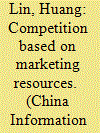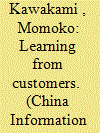|
|
|
Sort Order |
|
|
|
Items / Page
|
|
|
|
|
|
|
| Srl | Item |
| 1 |
ID:
087431


|
|
|
|
|
| Publication |
2009.
|
| Summary/Abstract |
The purpose of this article is to examine the development process of marketing-resources-based competition in the Chinese market by using three case studies of South Korean firms: Samsung, LG, and Hyundai. This study first asks how Korean firms were able to develop a strong market position in China despite their inferior technology relative to Japanese firms and their late entry into the Chinese market vis-a-vis Japanese, American, and European firms. The second question is how Korean firms were able to overcome the challenges of fierce price competition in China and, in particular, how firms were able to evade confrontation with the Chinese firms. In this article, the strategies of latecomers in the global competitive market will be examined. The process of market entry and market position establishment by Korean firms in China will be described. This article also shows how the firms develop branding and marketing communication strategies. Product development capabilities with speed and differentiation are the basis of Korean firms' competitiveness in the Chinese and global markets. The conclusion posits the major findings within the perspective of marketing-resources-based competition and discusses the implications and limitations.
|
|
|
|
|
|
|
|
|
|
|
|
|
|
|
|
| 2 |
ID:
087426


|
|
|
|
|
| Publication |
2009.
|
| Summary/Abstract |
Joint ventures in China between Japanese and Taiwanese firms have been increasing since the end of the 1980s. However, the literature suggests that the performance of joint ventures with third-country-based firms is the lowest among all types of joint ventures. The reasons attributed are that this type of joint venture lacks local access through a local partner and entails higher organizational costs, stemming from the large cultural distance between investing parties at both the national and corporate levels. Proving otherwise, this article preliminarily shows that the termination rate of Japanese-Taiwanese joint ventures in China is not necessarily high compared with that of overall Japanese investments in China. Joint ventures with Taiwanese companies improve local access for Japanese partners by making it easier to: (1) access Taiwanese affiliates with a large economic presence in China; (2) facilitate smooth entry into the local market by utilizing distribution networks that Taiwanese parties possess there; and (3) gain local information from Taiwanese partners whose language and culture are similar to China's. The article also suggests that organizational costs are reduced because of the mutual trust built as a result of the long history of collaboration between Japanese and Taiwanese partners.
|
|
|
|
|
|
|
|
|
|
|
|
|
|
|
|
| 3 |
ID:
087430


|
|
|
|
|
| Publication |
2009.
|
| Summary/Abstract |
This article explores the firm-level competitive edge that underlies the dominance of Taiwanese manufacturers in the global production of notebook PCs. Based on the study of the business flow of original design manufacturing trade and the author's interviews with outsourcing and subcontracting firms, the article argues that the successful formation of multifaceted capabilities in product development, mass production, and logistics, as well as the creation of information advantages, underpin the drastic rise of Taiwan's position in the global competitive landscape. The article also examines the mechanism through which such firm-level competitiveness has been created, and it argues that the unique attributes of the notebook PC value chains have allowed Taiwanese firms to effectively absorb technology, know-how, and information by interacting with and learning from a wide variety of customers, and thus enhance their competitiveness as original design manufacturing suppliers.
|
|
|
|
|
|
|
|
|
|
|
|
|
|
|
|
| 4 |
ID:
087433


|
|
|
|
|
| Publication |
2009.
|
| Summary/Abstract |
Offshore R & D by multinational corporations (MNCs) has increasingly involved the developing world in East Asia, initially Taiwan and Korea but more recently China and India. However, the R & D mandates of foreign R & D facilities in this region tend not to follow the paths of evolutionary models. To explain this phenomenon, this article presents a conceptual framework, essentially based on Dunning's eclectic paradigm, with a strong flavor of the evolutionary approach to technology, but which, in some cases, also allows for leapfrogging competition. In terms of empirical work, the article also explores the relationship between MNCs' overseas R & D mandates and the locational advantage of the host country by conducting case studies on flagship MNCs' R & D facilities in the information technology sector on both sides of the Taiwan Strait. The results show some interesting contrasts across the Taiwan Strait that run counter to the evolutionary perspective. There are grounds to suggest that such contrasts have much to do with the locational advantages Taiwan and China each possess. Further implications are drawn to enrich the current understanding of R & D internationalization.
|
|
|
|
|
|
|
|
|
|
|
|
|
|
|
|
| 5 |
ID:
087427


|
|
|
|
|
| Publication |
2009.
|
| Summary/Abstract |
Two large Japanese convenience store chain companies, namely 7-Eleven Japan and FamilyMart, both of which set up businesses in China in 2004, have followed entirely different strategies. FamilyMart chose a team management strategy which is distinguished by fully utilizing the resources of its Taiwanese subsidiary and forming a partnership with a big Taiwanese business group, Ting Hsin International Group in China. By contrast, 7-Eleven Japan built up its China subsidiary almost wholly by itself, a policy that can be described as a managing-alone strategy. The differences in strategy stem fundamentally from differences in the two companies' experience of international management and from the knowledge derived from that experience. And their choice of strategies has also been shaped by the interactions between two Taiwanese business groups, namely the Ting Hsin International Group and the President Group. Furthermore, we find that FamilyMart's strategy enabled it to build up its operations more quickly than the policy adopted by 7-Eleven Japan. Although the latter's strategy is more time-consuming, it offers a stronger possibility of establishing a more efficient and more transparent business model than the approaches followed by other convenience store chains.
|
|
|
|
|
|
|
|
|
|
|
|
|
|
|
|
|
|
|
|
|